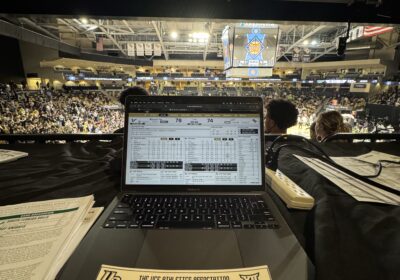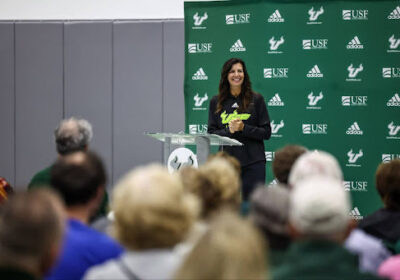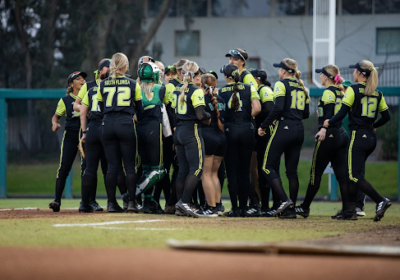Analysis: As college football season nears, it’s time to face a tough decision
The college football season is in serious jeopardy.
Campuses remain closed amid the coronavirus pandemic and most, if not all, reputable NCAA institutions are not allowing students to take in-person classes until at least the fall.
Some schools, like Boston University (though it hasn’t fielded a football team since 1997) admit classes may not resume in person until next spring.
Meanwhile, UConn President Tom Katsouleas told a journalism class that his university’s “[c]urrent thinking is that likely fall sports will be canceled — with the exception of those that can be played at a safe distance” — though the university later walked that statement back, saying that would only happen if conditions don’t improve, which seems like an obvious statement.
If schools wind up prohibiting in-person gatherings or classes on campus, it’s ridiculous even thinking about the idea of getting football teams together. With roster sizes that near 100, coaches and support staff, as well as media gatherings — all told, that would probably fill up the auditorium in USF’s University Lecture Hall building.
Due to the massive nature of college football, television contracts and all, there’s only so long the NCAA can wait to take action, as waiting for certain academic institutions to do something as they “continue to monitor the evolving outbreak” just won’t suit ESPN, CBS and Fox.
Players tend to report from mid-June to early July, so assuming things don’t improve drastically in the next month, the season simply won’t be able to start on time. Here are some alternatives, based on how reasonable they are.
Move the season to the spring
If the season can’t be played as scheduled in the fall, this may be the easiest change to make.
Simply move the entire season, as originally scheduled, and have it kick off in mid-January. USF would still travel to Texas in Week 1, only it would happen Jan. 16, 2021, instead of Sept. 5, 2020.
Using that kickoff date, conference championship Saturday would fall April 10 or thereabouts, Army-Navy would play April 17 and bowl season would commence the next weekend, with the College Football Playoff semifinals taking place in early-mid May.
Pros: This is the most likely scenario where a full season could be played with fans. Stakeholders like the NCAA, individual schools and TV networks take the least possible hit in this scenario, leading to less collateral damage (i.e. cutting Olympic sports).
Cons: How do you seriously start the 2021 season on time if the national championship game isn’t until May? What about the NFL Draft and the combine? How reasonable is it to play the majority of the football season in a place like Minnesota, where the average low temperature in the Twin Cities in February is in the low teens? How hard a hit will basketball and spring sports take with football around at a time ordinarily not dominated by the sport?
Verdict: Again, it’s the easiest change to make, and almost assuredly the plan with the least casualties as a result. If a change must be made to the season, this is the one.
Mirror the college basketball season
In a scenario where campuses aren’t open in time for the fall semester to begin, but conditions improve to the point that it’s clear classes will resume in person in the spring and in-person academic services resume in, say, October, camps could begin, and the season could start in November or December.
This at least gets the season over by April, possibly even as early as March, allowing for seniors to both play their final collegiate season as well as participate in the NFL Draft and the events leading up to it.
Pros: A full season is played and is finished in time for the NFL Draft.
Cons: While it’s every sports fan’s dream, college football bowl season and March Madness lining up at the same time would be bad for TV and for schools, as viewership would be split for each.
Verdict: At least in the previous scenario, the end of the football season up north would have decent weather. This would just be bad weather all around. But it’d work.
Play a conference-only schedule starting in March
In this scenario, it’s not prudent enough to begin play by early January, but is by mid-spring.
Teams would play an eight-game conference schedule, conference championships would be the next week, then immediately jump into the College Football Playoff, scrapping almost every other bowl in the process.
FBS Independents would either have to join an existing conference for a year or join together as their own league temporarily.
Pros: The season gets played. Fewer games means less of a toll on players’ bodies.
Cons: All of the same downsides of the prior plan still apply, plus, with the season actually ending later in this scenario, it throws more doubt in the air about the 2021 season. Losing nonconference games will cost smaller schools big paydays, as well as TV big ratings from rivalries like Notre Dame-Southern California. If conditions aren’t good enough in January to play games, will fans even be allowed in stadiums by March?
Verdict: There have been scenarios floated where something like this happens in the late fall as well, but that would clearly be inferior as it cuts nonconference matchups.
Regardless, this situation should not be anyone’s first choice, but if it comes to pass, so be it.
Do nothing and postpone until it’s safe to play
This is the equivalent of kicking the can down the road.
The NCAA doesn’t cancel anything, doesn’t make any other plans and just keeps postponing the season — perhaps one month at a time — and hopes for things to get better.
Pros: None.
Cons: TV networks still need a heads-up before dedicating every Saturday afternoon for the next 15 weeks to college football, especially if every other sport is coming back, too. Some conferences, like the AAC, may find themselves on the outside looking in if they don’t have a solid enough plan in place in advance.
Verdict: In all honesty, it’s a terrible strategy to not have a plan in place, but it’s not like any professional sports league has one yet.
Cancel 2020 and try again next fall
Let’s cut to the chase.
Pros: What’s less than none?
Cons: Prepare to say goodbye to a lot of sports at some large schools. Cincinnati has already cut its men’s soccer program because of the pandemic despite nothing happening to football yet. Prepare to say goodbye to a lot of football teams at smaller schools, even.
Verdict: Look, we have to acknowledge this is a very real possibility, but just the thought of the ripple effect is scary.







